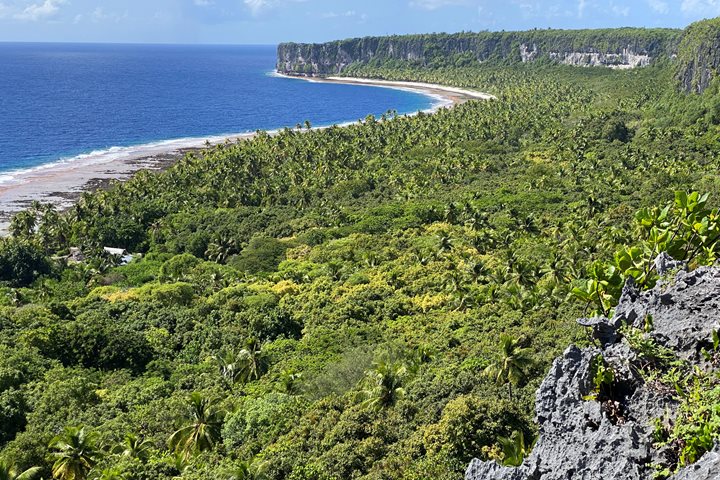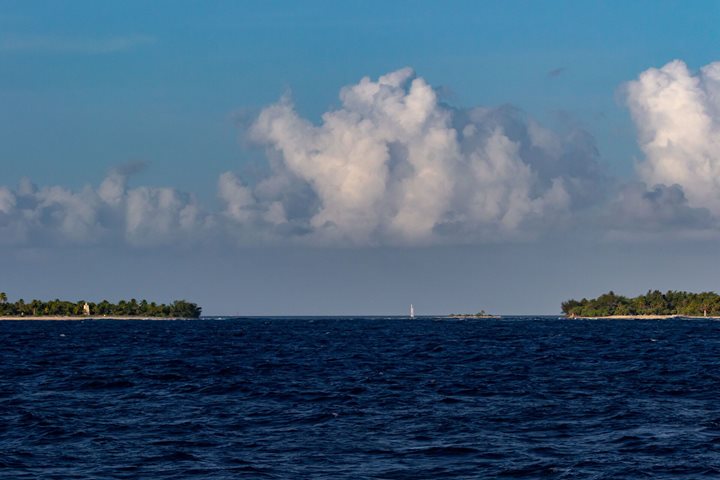Early this morning, we got sight of a small, rugged-looking island far off on the horizon. This was almost as exciting to us as it must have been for the HMAV Bounty mutineers and their Tahitian companions on January 15th, 1790 after their long search for this very same island. The island was reported by Europeans in 1767 and was named Pitcairn’s Island, after the sailor who first sighted it. At the time of discovery, no landing was attempted, and it was incorrectly charted, making it very difficult for the mutineers to find. This isolated volcanic structure rises about 1,100 feet (330 meters) above the ocean’s surface and has a land area of only 1.75 square miles. Pitcairn Island is roughly situated midway between Panama and New Zealand. Archaeological evidence shows that the island was part of an important but restricted Polynesian trade system that also included Henderson Island and Mangareva Island (the French Polynesian island from where we have just come). Pitcairn Island was inhabited for several centuries by Polynesians up until about 1500. From that time, it remained uninhabited until the coming of the Bounty mutineers led by Fletcher Christian in 1790. The new wave of settlers included nine mutineers, twelve Tahitian women, and six Tahitian men, and very soon, children were born. Although the island must have seemed like a virtual paradise upon arrival, the tiny community endured considerable discord and then violence between the British mutineers and the Tahitian men in the ensuing years. By 1800, only one of the original men (mutineer Alexander Smith, a.k.a. John Adams) was still alive. He became the leader of the community that then included nine Tahitian women and numerous children. They remained totally isolated until they were discovered in 1808 by the American sailing ship Topaz under the command of Mayhew Folger. Their descendants today are a unique blend of European and Polynesian cultures, genetics, and languages, and it is very pleasing to hear the local Pitkinese language spoken among residents.
Pitcairn Island became a British colony in 1838. By the 1850s, the community was outgrowing the island, so its leaders appealed to the British government. The Pitcairn islanders were offered Norfolk Island, and on May 3, 1856, the entire community of 193 people left for Norfolk. After eighteen months on Norfolk, seventeen of the Pitcairners decided to return home. Five years later, another twenty-seven did as well, and Pitcairn has been continuously inhabited ever since. The population peaked at 233 in 1937, and it has since fallen severely due to emigration, leaving less than fifty people living on Pitcairn today. The islanders converted to the Seventh Day Adventist Church in the 1880s, so tobacco, consumption of liquor, and pork are not allowed on the island. Gardening and fishing are important parts of the residents’ subsistence, and sometimes they produce enough to sell fresh vegetables to the rare passing ship. Pitcairn is governed under the British High Commissioner in New Zealand, who is Governor of Pitcairn and its associated islands, i.e., Henderson, Ducie, and Oeno Islands.
Upon arrival, we collected the officials in our Zodiacs for clearance into the United Kingdom. Mayor Melva gave us a wonderful presentation that introduced us to the island. By midmorning, the Zodiacs were ready, and we began what would certainly be one of the highlights of the voyage. Once ashore in the little harbor, we were welcomed by the islanders and made our way up a road known as The Hill of Difficulty to reach Adamstown (named for John Adams). Some of us walked up the hill, while others were given rides on the backs of local quad bikes. It is important to realize our visit was as meaningful to the islanders as it was to us. The island gets very few visitors, and the staff and crew have many friends living here. The Pitcairn islanders are renowned for their artistic abilities, and the handicrafts produced here are valued by collectors around the world. There were market stands along the road and in the Main Square where local artisans sold wooden bowls and carvings made from miro wood or Polynesian rosewood, as well as postcards and other souvenirs. Word was they did very well with us insofar as selling merchandise is concerned, which is helpful to the island’s residents.
In the afternoon, we divided into groups to enjoy different activities available here on the island. A few guests opted for a difficult but rewarding hike to the highest point of the island for spectacular views. Several others hiked up to Christian’s Cave, a famous grotto that Fletcher Christian visited to retreat from his compatriots and meditate. Several other guests walked to the easternmost point of the island to visit St. Paul’s Pool, a natural swimming hole that is both filled and emptied by the sea. A few of our people managed a swim in the sheltered waters of the innermost section. Most of our group, however, went on a walking tour of the environs of Adamstown. We saw John Adams’s grave (along with the graves of his wife and daughter), historic homesites, giant banyan trees and other lush vegetation, overlooks, and the historic cemetery. The wonderful museum, with its collection of HMAV Bounty items that have been salvaged from the wreck, was extremely interesting. There was a lot to see and do here, and everyone had plenty of time to experience the island and its amazing history as they saw fit. We returned to the ship tired but satisfied. It had been a remarkable and successful day.







